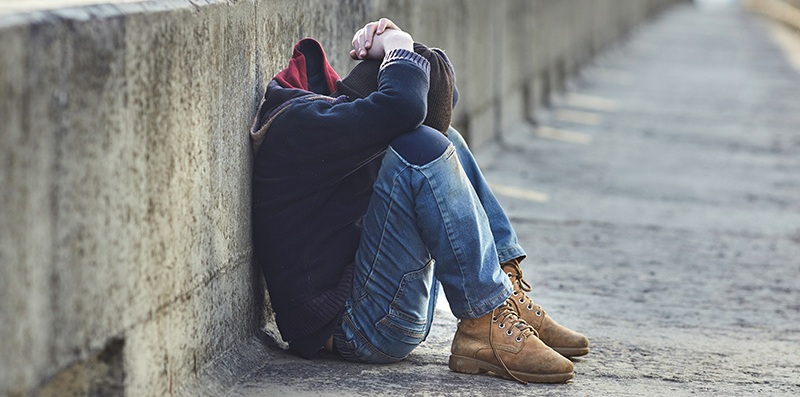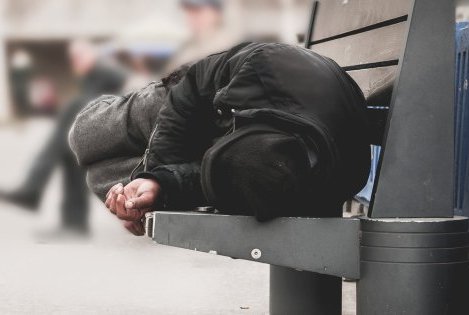
Think about the following questions.
1. Has anyone you know or know of run away from home? What happened?
2. What are some reasons that teens might run away from home?
3. Are there ways for teenage runaways in your country to get help?
VOCABULARY PREVIEW
Match each New Academic Word List(NAWL) word with the correct definition.
- precede _____
- precipitate _____
- trauma _____
- motive _____
- diagnostic _____
- psychiatric _____
- a. to cause to happen
- b. a reason for doing something
- c. used to help identify a disease, illness, or problem
- d. a very difficult or unpleasant experience
- e. to come before
- f. of or relating to a branch of medicine dealing with mental or emotional disorders
TEENAGE RUNAWAYS

Mark Twain's book The Adventures of Huckleberry Finn is considered one of the greatest works of American literature. It is the story of a boy who runs away from home, in part because of his abusive father. In keeping with the American concept of individualism, the boy's experiences as a runaway, both good and bad, help him grow as a person and establish his independence and maturity. The plight1 of modern runaways, however, differs greatly from Twain's narrative.
A runaway, or "youth in crisis," is a child or teen who chooses to leave home without parental consent; most are unprepared for such independence. According to the Children's Defense Fund, as many as 7,000 young Americans run away every day. Seventy-five percent of these youths depend on friends or relatives for food and shelter. For the remaining twenty-five percent, life on the street is anything but romantic. In fact, it is even prohibited by law in some parts of the United States and other countries. Habitual2 runaways who are under the age of eighteen may be sent to a facility for wards3 of the state, or even juvenile detention centers if they are caught breaking other laws, such as those against vagrancy4, trespassing, or petty theft5. Many runaways become involved in crime as a result of their circumstances; often, the only ones willing to help them have predatory6 motives. The trauma that teenagers face in this situation would be difficult enough without these added troubles from people around them.
Regardless of whether they are caught for minor crimes, homeless life is unpleasant and dangerous. In the United States, for example, social services for runaways tend to be underfunded and understaffed. Runaways often become the victims of violence or theft at insufficiently monitored shelters—even more so than on the streets. And homelessness is often accompanied by health threats, such as hygiene7 issues, poor nutrition, food poisoning, and exposure to cold.
The rates of substance abuse among runaways are far above national averages. Alcohol use, for instance, is at eighty-nine percent for US runaways, compared with thirty-five percent among their non-runaway peers. This is in part because many runaways began with addictions that preceded and sometimes precipitated their leaving home. Young girls are particularly at risk for rape, sexually transmitted diseases like AIDS, and pregnancy. And the longer a teenager remains on the streets, the less likely he or she will be to go to college or learn a trade later on. While running away may seem to be an escape from an intolerable8 situation, homeless life provides neither shelter nor relief.
For runaways, the motivation behind the act is usually less the assertion of free will than the urgent need to escape, as they are almost always escaping from something or someone. The most commonly cited reason for running away, at thirty percent of youths polled by the National Runaway Safeline (NRS), is family dynamics. One or both parents may suffer from alcoholism or some other addiction. Youths from families with one or more parents who have substance abuse problems are particularly at risk of neglect or abuse, whether physical or emotional. In situations of chronic9 abuse, running away may seem reasonable. While a teenager's desire to flee an abusive home life is understandable, there are cases where the source of motivation is less obvious.
Teenagers occasionally run away from stable households, too. When contacted, youths in crisis also cite problems with peers, economic problems, or psychological problems. According to data collected by the US National Institutes of Health, homeless and runaway youth are six times more likely than their non-runaway peers of the same age to meet the diagnostic criteria for at least two mental disorders. And they are seventeen times more likely to meet the criteria for one disorder.
Runaways who require psychiatric treatment, which in most countries the state is not obliged to provide, present a unique problem. If families are also unable to provide this sort of treatment, it is likely to lead to a vicious circle10. While improved social programs can help in keeping runaways physically safe, this alone does nothing to address psychological issues. Although there are more questions than answers about appropriate treatment options, one thing is certain: runaways need more help than they are receiving.
New Academic Word List
- plight 1 : n. a difficult or unfortunate situation
- habitual 2 : adj. done regularly or repeatedly
- ward 3 : n. a person under the protection of someone else
- vagrancy 4 : n. the state of being homeless and living in public places
- petty theft5 : n. the stealing of small amounts of money or items of little value
- predatory 6 : adj. wrongly harming or using others for pleasure or profit
- hygiene 7 : n. the things one does to keep oneself clean in order to stay healthy
- intolerable8 : adj. impossible to put up with; unbearable
- chronic9 : adj. continuing or occurring again and again for a long time
- vicious circle10 : n. a repeating situation in which one problem causes another problem, which in turn makes the first problem worse
READING COMPREHENSION
A ‣ Mark each statement as true (T) or false (F) according to the reading.
- Youths who run away regularly may end up at a government-run facility.
- True
- False
- Young runaways often find themselves exploited by criminals.
- True
- False
- In the US, social services for runaway teens are very well funded.
- True
- False
- Teenagers sometimes run away from homes where there are no incidents of abuse.
- True
- False
- A higher proportion of runaways experience mental illness than others of the same age.
- True
- False
B ‣ Choose the best answer according to the reading.
- What is the reading mainly about?
- a. The dangers faced by teen runaways and why they leave home
- b. The current state of social services devoted to runaway youths
- c. The alarming incidents of crime committed by runaway youths
- d. The psychological problems common among teen runaways
- What is the main idea of paragraph 1?
- a. Running away has changed little since Mark Twain wrote about it.
- b. Huckleberry Finn's running away is quite unlike the realities of today.
- c. Mark Twain's book presented social commentary way ahead of its time.
- d. Today's youth should study the message of The Adventures of Huckleberry Finn.
- The word those in paragraph 2 refers to _____.
- a. laws
- b. wards
- c. centers
- d. runaways
- Which statement would the passage writer most likely agree with?
- a. Parents should be stricter with their children to stop them running away.
- b. Governments need to make the mental health of young people a priority.
- c. Juvenile detention centers should receive more funding to take in more youths.
- d. Young people should be encouraged to run away to establish their independence.
C ‣ Look for the answers in the reading and write them on the lines.
- What can happen to runaways who are caught committing crimes?
_____ - What are some health threats that a runaway might face on the street?
_____
SUMMARY
Write the number of each sentence under the category it belongs to.
| Teenage Runaways | |
| Risks 1 _____ |
Reasons for Running Away 2 _____ |
- Runaways may become the victims of crimes in shelters or on the streets.
- A large percentage of runaways have pre-existing mental disorders.
- Many runaways come from families with addiction and abuse issues.
- Runaways may experience food-related problems, like malnutrition or food poisoning.
- Some teens have substance abuse issues before they run away.
- Many runaways are lured into crime by people who say they wish to help them.
VOCABULARY PRACTICE
Fill in the blanks with the words in the box. Change the form if necessary.
- diagnostic
- motive
- precede
- precipitate
- psychiatric
- trauma
- A sudden drop in air pressure usually _____ a big storm.
- People who were once labeled with character problems are now recognized as simply needing _____ care.
- Although experts are not certain, some studies suggest that fracking may _____ minor earthquakes.
- It is difficult for many people to trust they know the real _____ of politicians.
- The _____ of war is by no means limited to soldiers-regular citizens suffer, too.
- Standardized IQ tests were primarily developed as _____ tools; they were supposed to help institutions identify people with mental disorders.
SUPPLEMENTAL READING
Signs of a Troubled Teen

Nearly all runaways come from homes in which there are clear problems. It is important for parents to be aware of the possibility that their child may run away and of the warning signs that often precede it.
One major warning sign is a sudden change in behavior. This change may be one of eating or sleeping habits. A young person may suddenly start overeating or not eating enough. He or she may begin sleeping all day or staying up all night. Changes in social habits can also indicate problems, particularly when a teenager becomes withdrawn from friends and outside contacts. If a young person begins to show sudden swings in mood, going from very happy to very sad, for example, there is a good chance that he or she is undergoing some sort of stress that is difficult to resolve.
Other warning signs include sudden rebellious behavior like fighting or skipping school, as well as accumulating money, clothes, and other personal items in one place, like a bag or backpack. Parents may even hear their child talk about his or her intention to run away. Such information should be taken seriously and not dismissed as a simple plea for attention.
To prevent a child from running away, the most important thing a parent can do is to show care and understanding. Confronted with the warning signs, parents should not wait; they should immediately show their concern and their desire for their child to remain home. And whenever possible, mental-health professionals recommend that the child receive some form of counseling.
Fill in the blanks with information from the reading.
- Sudden changes in _____ , _____, or social habits are a warning sign.
- Teens who intend to run away might store money and clothes in a(n) _____.
- Professionals say that children in danger of running away should get _____.

Leave a comment
Load more